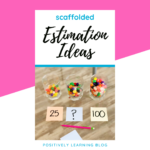
A Math Club at school? Who wouldn't want to join? Here are some “quick start” ideas for starting a math club with your intervention groups!

Table of Contents
ToggleAs most special educators already know, the best teaching ideas don't come from textbooks, but instead from other educators (with a hint of desperation thrown in, lol).
I found myself with one “common” time when I could pull a math group with students. This was twenty minute block when students wouldn't be missing anything else from their day.
A twenty minute math content block has pros and cons:
PROS – you can accomplish so much in twenty minutes PLUS attention spans often don't get too much farther past the 20:00 mark.
CONS – once everyone gets transitioned and settled, there's not enough time to set up a rotation (students moving to stations and the small group table)
What's the solution? You probably already guessed it…
Here's all you need to get started (and I bet you already have ALL of these!):
That's it!
Are you working with as many different math skills and levels as students?
Do you have math centers prepared for hands-on learning?
Do you have some type of system for tracking student progress?
I bet you have ALL of these items already! Now it's simply a matter of getting organized and inviting your students to join the club!
The key is to have enough materials organized for students to enter your classroom space and begin working individually. Here are some quick math solutions to get started:
It's also fun (and effective) to have one open-ended math task for all students to solve – here's one my students LOVED:
Grab your jellybeans (or substitute your favorite snack, like crackers, or math manipulative):
Students use the container with 25 and 100 to compare the “mystery number” container in the middle.
Please Note: for K-2 students, we're not focused on getting the “correct” answer, but instead using our math language to draw a conclusion.
What if you created a different themed estimation activity every month?!?
Hmmmm….
Hope these math suggestions sparked some ideas for your math club!
Which one will you try first?


I’m Jennifer and I was a special educator in the elementary school setting over the past decade. I entered the classroom every day dedicated to making learning inclusive AND engaging.









This website uses cookies to ensure you get the best experience on our website. See full disclosure here.
This website uses cookies to ensure you get the best experience on our website.
See full disclosure here.